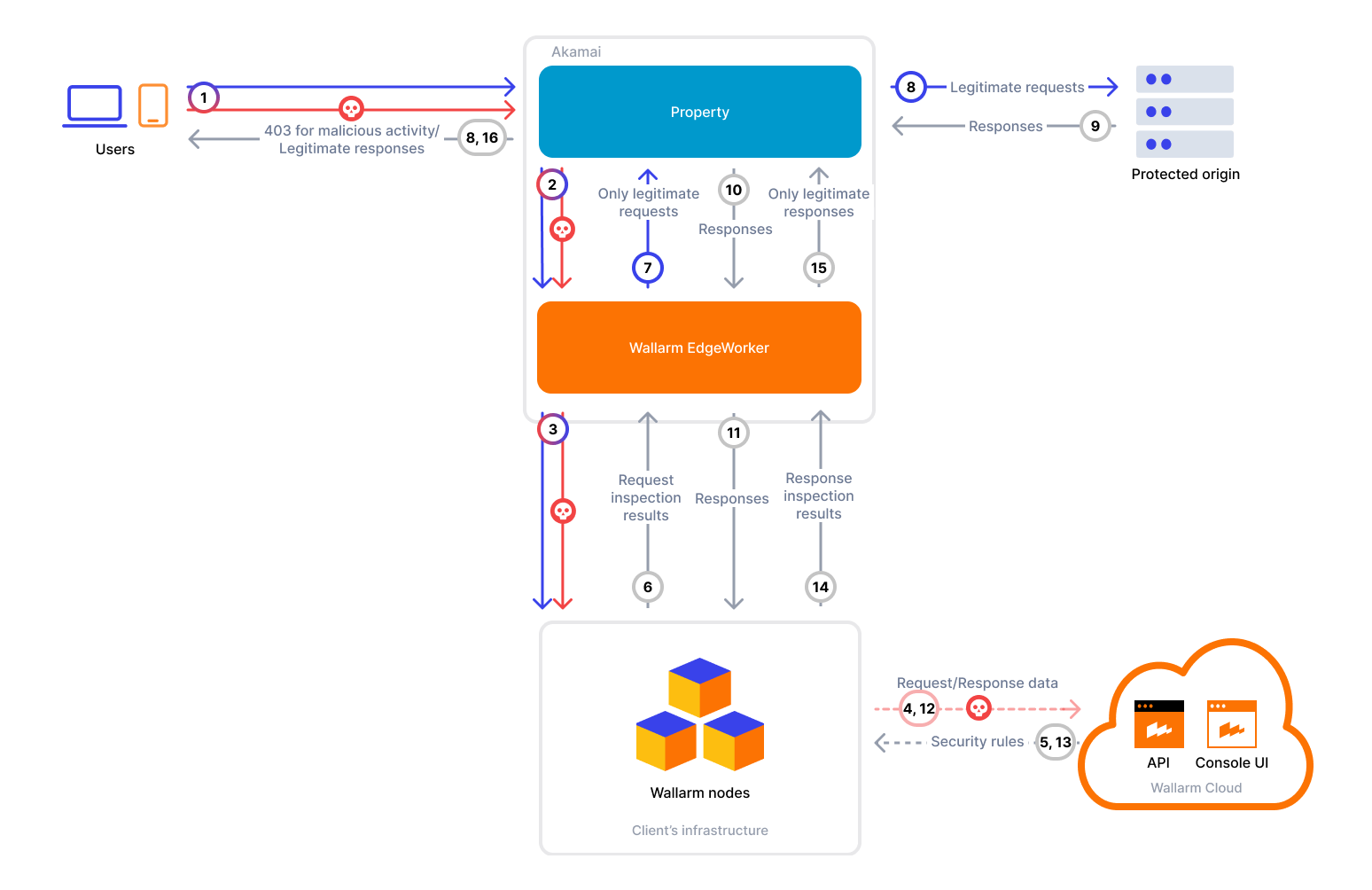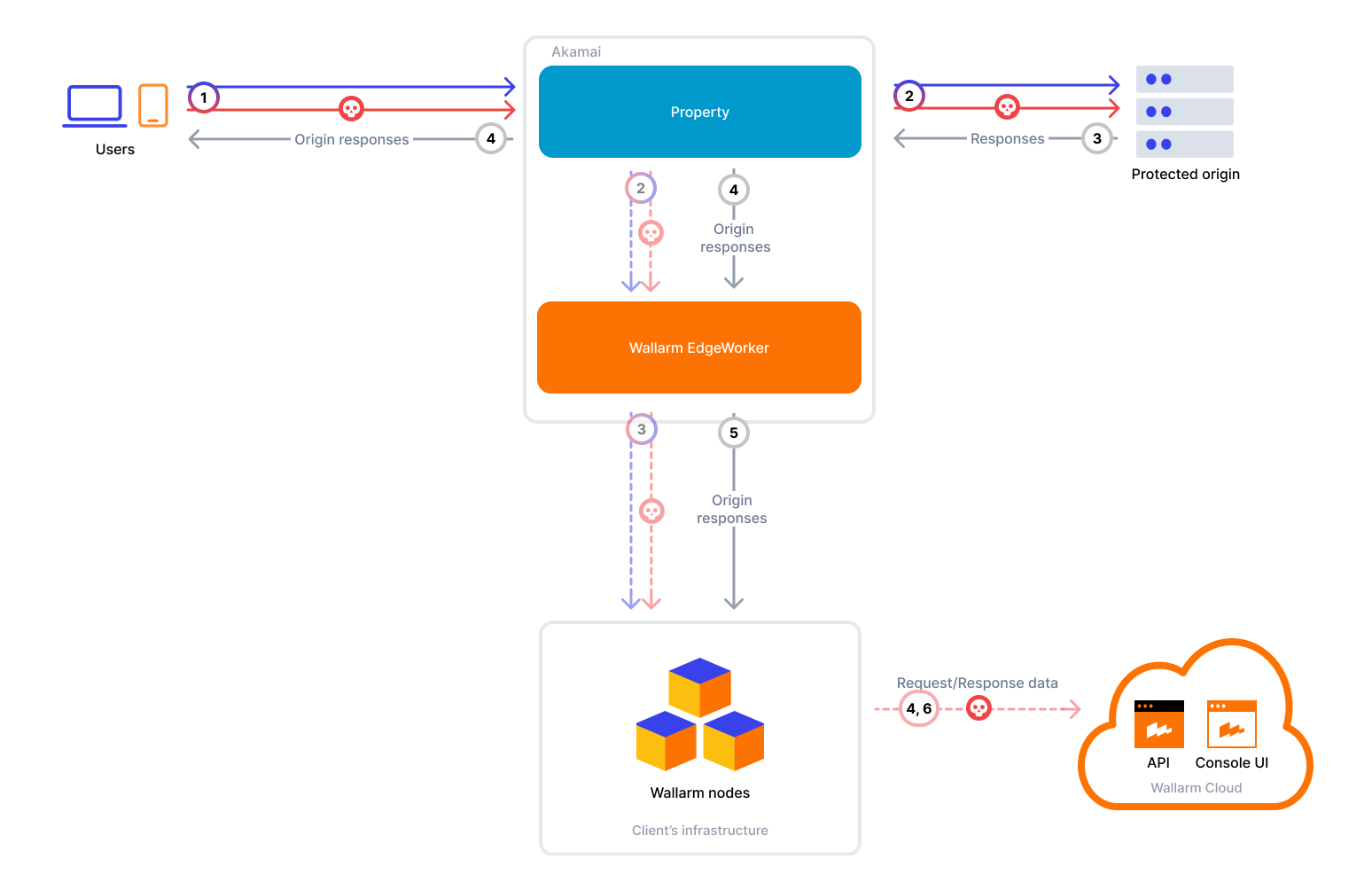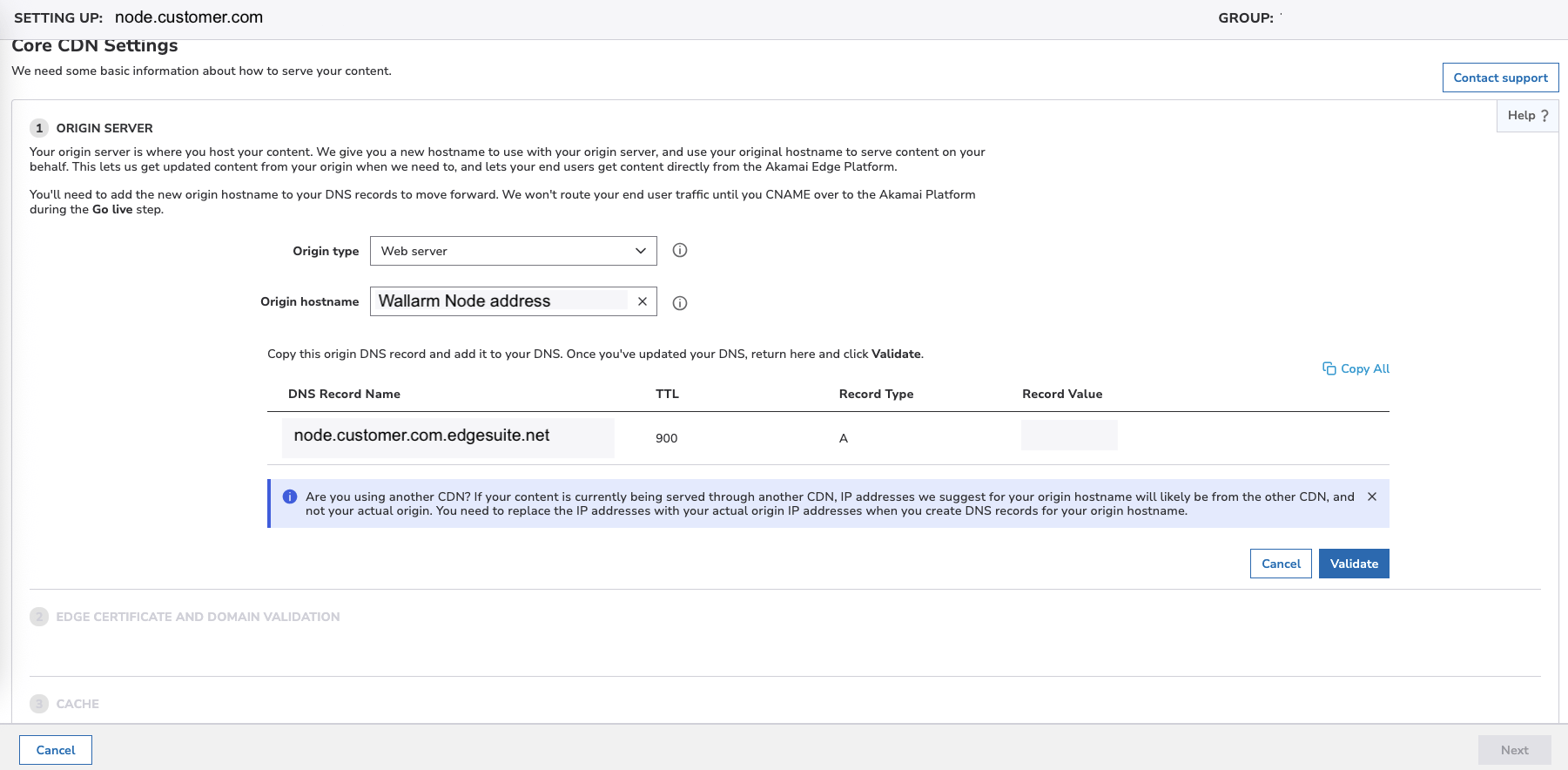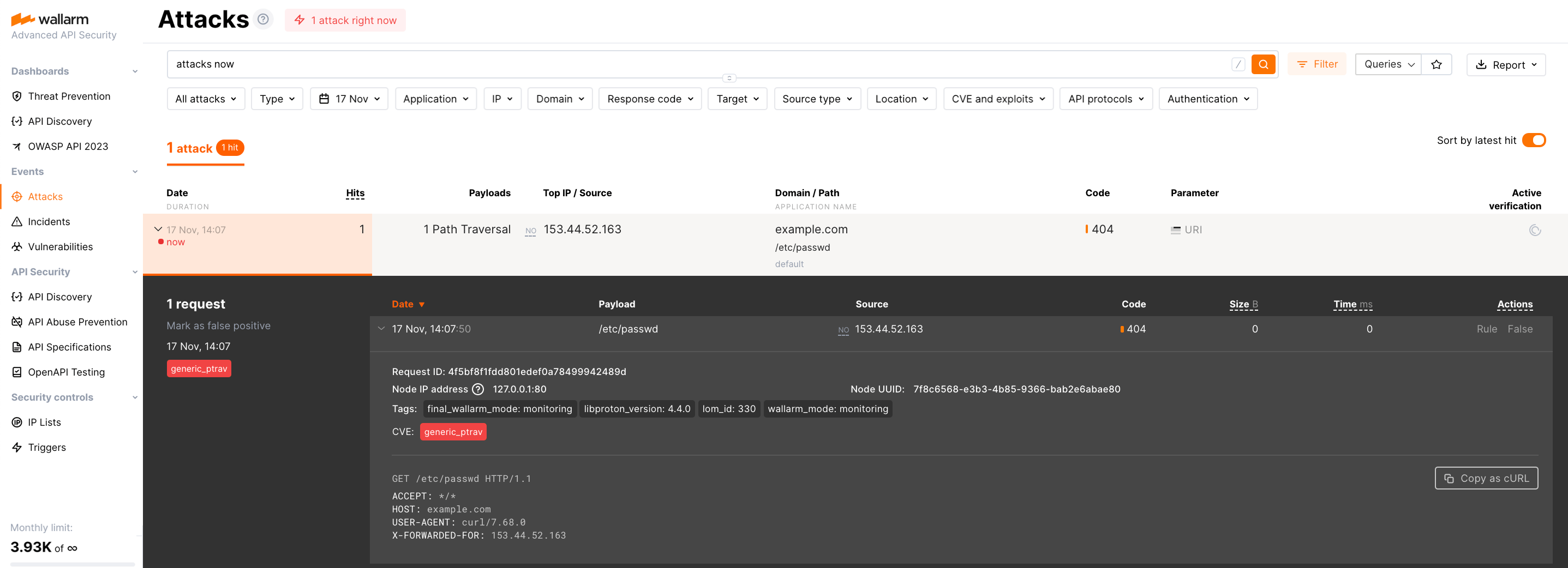Wallarm Connector for Akamai¶
For customers delivering their APIs through Akamai CDN properties, Wallarm provides a dedicated EdgeWorker code bundle. By deploying this EdgeWorker, requests are routed to a Wallarm node for inspection and protection before reaching the origin. This approach allows customers to secure their API traffic directly at the edge without changes to the origin infrastructure.
To use Wallarm as a connector for Akamai, you need to deploy the Wallarm node externally and apply the Wallarm-provided code bundle in Akamai to route traffic to the Wallarm node for analysis.
The Wallarm connector for Akamai supports both synchronous (in-line) and asynchronous (out‑of‑band) traffic analysis:
Use cases¶
This solution is recommended for securing APIs delivered through Akamai CDN.
Limitations¶
The Wallarm connector for Akamai has certain limitations:
-
When deploying the Wallarm service with the
LoadBalancertype using the Helm chart, a trusted SSL/TLS certificate is required for the domain. Self-signed certificates are not yet supported. -
Custom blocking page and blocking code configurations are not yet supported.
All blocked malicious traffic is returned with status code
403and the default block page. -
Rate limiting by Wallarm rules is not supported.
Rate limiting cannot be enforced on the Wallarm side for this connector. If you need rate limiting, use the features built into your API gateway or cloud platform.
-
Multitenancy is not supported on Security Edge hosting, but it is supported for a self-hosted node deployed with the connector.
In addition, the following EdgeWorkers platform restrictions affect the connector design:
-
httpRequest domain restriction – sub-requests made from an EdgeWorker must target a domain already served by Akamai (i.e., a configured property)
-
HTTPS-only sub-requests – if another protocol is specified, EdgeWorkers automatically convert it to HTTPS
-
Event model limitation – request and response bodies are accessible only within the
responseProviderevent
Because of these restrictions, the Wallarm EdgeWorker is implemented as a responseProvider function that issues a sub-request back to the same property. This sub-request includes the custom header x-wlrm-checked, which prevents infinite loops and allows routing traffic to the Wallarm node.
Requirements¶
To deploy the Wallarm EdgeWorker on Akamai, make sure the following requirements are met:
-
Understanding of Akamai technologies
-
Akamai EdgeWorkers enabled in your contract
-
Origin backend available
- Your API services running on a reachable origin server
- Origin domain resolves to the Akamai property hostname via a CNAME record
-
Akamai property configured to forward traffic to the protected origin
- The property must include the Default Rule with the Origin Server behavior
- The property must have a valid TLS certificate for the served host
-
Control over a DNS zone (e.g.,
customer.com) and readiness to allocate a dedicated subdomain (e.g.,node.customer.com) for the Wallarm Node propertyAfter the property is created, Akamai will return an Edge Hostname (e.g.,
node.customer.com.edgesuite.net). You must create a CNAME record in your DNS that points the chosen subdomain to this Edge Hostname.
Deployment¶
1. Deploy a Wallarm node¶
The Wallarm node is a core component of the Wallarm platform that you need to deploy. It inspects incoming traffic, detects malicious activities, and can be configured to mitigate threats.
You can deploy it either hosted by Wallarm or in your own infrastructure, depending on the level of control you require.
To deploy a Wallarm-hosted node for the connector, follow the instructions.
Choose an artifact for a self-hosted node deployment and follow the attached instructions:
- All-in-one installer for Linux infrastructures on bare metal or VMs
- Docker image for environments that use containerized deployments
- Helm chart for infrastructures utilizing Kubernetes
Required Node version
Please note that the Akamai connector is supported only by the Native Node version 0.16.3+.
2. Obtain the Wallarm code bundle and create EdgeWorkers¶
To acquire and run the Wallarm code bundle on Akamai EdgeWorkers, follow these steps:
-
Contact support@wallarm.com to obtain the Wallarm code bundle.
-
Go to Akamai Control Center → EdgeWorkers → Create EdgeWorker ID, then import the code bundle
wallarm-main.This is the main EdgeWorker that routes requests through the Wallarm node.
-
Create another EdgeWorker ID and import the
wallarm-spbundle.This is the EdgeWorker recommended for spoofing prevention. It does not require a property.
3. Create the Wallarm Node property¶
-
In Akamai Property Manager, create a new property:
- Property name / hostname: the dedicated Node hostname (e.g.,
node.customer.com). This hostname must belong to a DNS zone you control. - Property type:
Dynamic Site Accelerator. - Origin type:
Web server. - Origin Hostname: the actual address of your deployed Wallarm Node.
- Property name / hostname: the dedicated Node hostname (e.g.,
-
Configure TLS for the property:
- Either select an Akamai Managed Certificate (Akamai will issue and maintain a certificate for
node.customer.com), or - Upload your own certificate if required.
- Either select an Akamai Managed Certificate (Akamai will issue and maintain a certificate for
-
Save the property. Akamai will generate an Edge Hostname, e.g.:
-
In your DNS zone, create a CNAME record pointing your Node hostname to the Edge Hostname, e.g.:
-
Activate the property in staging, verify functionality, then activate in production.
4. Configure variables in the origin property¶
Open your existing origin property → Edit New Version and configure the following variables:
| Variable | Description | Required? |
|---|---|---|
PMUSER_WALLARM_NODE | The property name that you have created for the wallarm-main EdgeWorker. | Yes |
PMUSER_WALLARM_HEADER_SECRET | Arbitary secret value for spoofing prevention, e.g. aj8shd82hjd72hs9. When the wallarm-main EdgeWorker forwards a request back into the same property, it adds the header x-wlrm-checked with this value. The wallarm-sp EdgeWorker validates the header: if it does not match, the request is blocked. It prevents infinite loops and ensures clients cannot add a fake header to bypass Wallarm checks.Keep private and do not reuse elsewhere. | Yes |
PMUSER_WALLARM_ASYNC | Determines traffic handling mode: false processes traffic through the Wallarm Node directly (synchronous), while true analyzes a copy of the traffic without affecting the original flow (asynchronous). Default: false. | No |
PMUSER_WALLARM_INSPECT_REQ_BODY | Controls whether to send request bodies to the Wallarm node for analysis or not. Default: true. | No |
PMUSER_WALLARM_INSPECT_RSP_BODY | Controls whether to send response bodies to the Wallarm node for analysis or not. It enables response schema discovery and enhanced attack and vulnerability detection capabilities. Default: true. | No |
You can fine-tune the connector mode and body inspection settings per-route or per-file type by using the Set Variable behavior.
5. Add Wallarm EdgeWorker rule¶
In the origin property, create a new blank rule:
-
Criteria:
-
Behavior: EdgeWorkers → the
wallarm-mainEdgeWorker
For more complex setups, you can combine this condition with path checks (e.g., apply the rule only to /api/* paths) so that only API traffic is processed by Wallarm.
6. Add spoofing-prevention rule¶
In the origin property, create another new blank rule:
-
Criteria:
-
Behavior: EdgeWorkers → the
wallarm-spEdgeWorker
This rule ensures that the header x-wlrm-checked matches the value of PMUSER_WALLARM_HEADER_SECRET. Any other value is blocked, preventing clients from bypassing Wallarm checks.
For more complex setups, you can combine this condition with path checks (e.g., apply the rule only to /api/* paths) so that only API traffic is processed by Wallarm.
7. Save and activate the property¶
-
Save the new origin property version.
-
After verification, activate in production.
Testing¶
To test the functionality of the deployed EdgeWorkers, follow these steps:
-
Send the request with the test Path Traversal attack to your Akamai CDN:
-
Open Wallarm Console → Attacks section in the US Cloud or EU Cloud and make sure the attack is displayed in the list.
If the Wallarm node mode is set to blocking, the request will also be blocked.
Upgrading the Wallarm EdgeWorkers¶
To upgrade the deployed Wallarm EdgeWorkers to a newer version:
-
Proceed to the EdgeWorker created for
wallarm-main. -
Press Create Version and upload the new
wallarm-maincode bundle. -
After verification, activate in production.
-
Repeat the same steps for the
wallarm-spcode bundle if its version changed.
EdgeWorker upgrades may require a Wallarm node upgrade, especially for major version updates. See the Native Node changelog for the self-hosted Node release notes. Regular node updates are recommended to avoid deprecation and simplify future upgrades.




